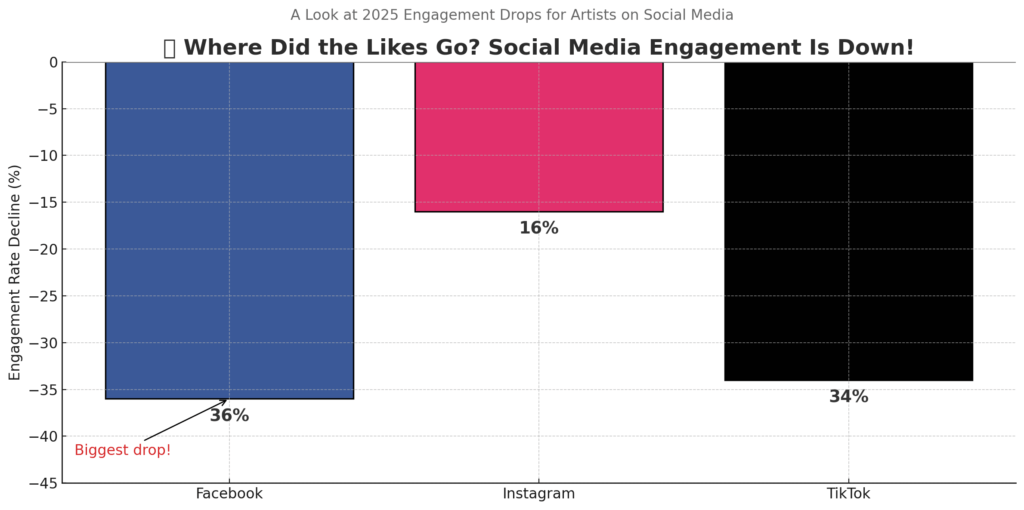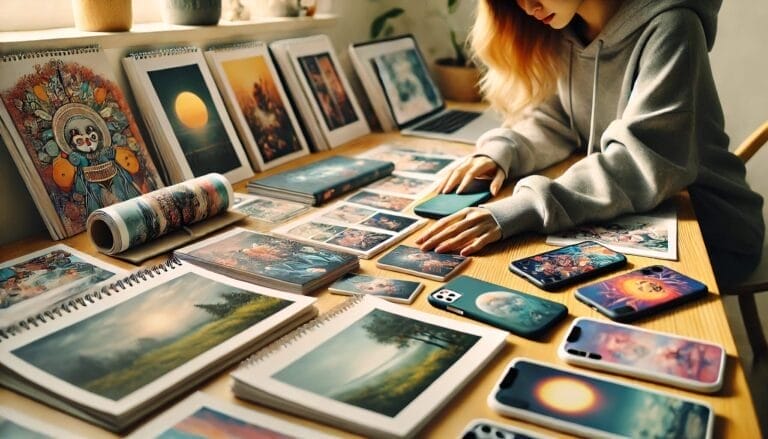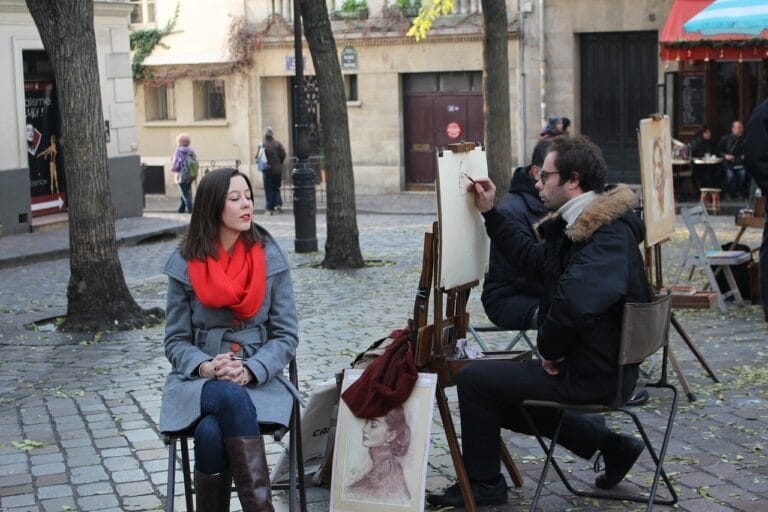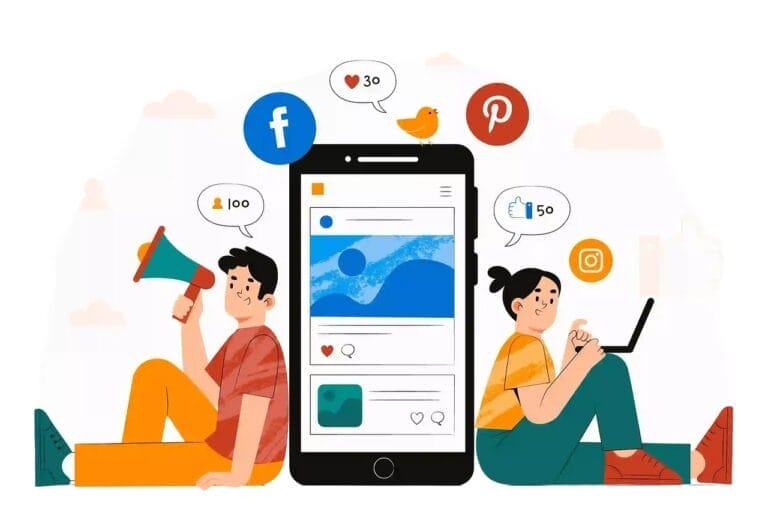A Wake-Up Call for Artists Relying on Likes to Sell Their Work
For artists today, making great art isn’t enough. You also need to be your own marketing team. Social Media for Artists promised to connect them directly with fans and buyers. But many artists now feel trapped in a frustrating game where the rules keep changing.
“I spent years building a following of 20,000 people on Instagram, but now my posts reach fewer than 500 of them,” says Maya Chen, a watercolor artist from Portland. “It feels like shouting into a void.”
Sound familiar? You’re not alone. Artists everywhere face this problem. Let’s consider why this happens and what you can do about it.
The Algorithm Problem
Social media platforms use algorithms to decide who sees your posts. These computer programs choose what content appears in people’s feeds. And they don’t care if you’re a talented artist who spent 30 hours on that painting.

The algorithms care about one thing: keeping people scrolling and seeing ads.
This creates several big problems for artists:
The Engagement Trap
Platforms favor posts that get quick likes, comments, and shares. A quick photo of your cat might get more engagement than your best artwork, which took weeks to create.
“I noticed my process videos and personal photos get way more likes than my finished artwork,” says landscape painter Tom Reeves. “It’s frustrating because I want to sell my paintings, not become a lifestyle influencer.”
The system pushes artists to make content that gets engagement rather than content that represents their best work or helps them sell.
This creates a distorted view of what is valuable. The pressure to constantly entertain or reveal personal moments erodes the focus on the art itself. Artists may start to question whether their work is worthy simply because it doesn’t perform well online – even if it’s some of their best creative output.
The Consistency Pressure
Algorithms reward accounts that post often. But making quality art takes time.
“When I don’t post for a week because I’m deep in a new painting, my next post performs terribly,” says oil painter Jasmine Wong. “It’s like the platform punishes me for taking time to create.”
Many artists feel stuck between making rushed art to feed the algorithm or taking their time and losing visibility.
This creates an unhealthy cycle of production that prioritizes quantity over quality. Artists may burn out trying to keep up. The creative process becomes less about flow and exploration, and more about content calendars and optimization. Instead of finding joy in making, artists are pulled into a productivity trap that stifles experimentation and growth.
The Pay-to-Play Reality
Remember when your posts reached most of your followers? Those days are gone. Platforms have reduced organic reach dramatically.
“I have 15,000 followers on Facebook, but without paying to boost my posts, only about 300 people see them,” says sculptor Marcus Johnson. “It feels like they’re holding my audience hostage.”
The platforms want you to pay for ads to reach the very followers who chose to follow you in the first place.
This shift turns social media from a community space into a monetized battleground. Independent artists, many of whom already operate on tight budgets, are forced to either pay up or stay invisible. It’s not a level playing field.
The system favors those who can invest in promotion, not necessarily those with the most meaningful or high-quality work. That leaves many talented creators unheard and unseen.

The Selling Problem
For many artists, creating and sharing work on social media is already a delicate balance of creativity, consistency, and self-promotion. But the moment you try to turn that visibility into income, everything becomes more complicated. Selling your art online should feel empowering—but instead, it often feels like the platforms are working against you.
The Commercial Content Penalty
Many artists notice posts about available artwork or sales perform worse than other content.
“As soon as I mention a painting is for sale or link to my website, my reach drops by half,” says Eliza Thornberry, who creates abstract acrylics. “The platforms seem to punish any hint that you’re trying to make money.”
This problem, often called the “commercial content penalty,” happens when social media platforms show fewer people your post just because you’re trying to sell something. For example, a study from Hootsuite found that LinkedIn posts without any links were seen by up to six times more people than posts with links.
On Facebook, research by Oneupweb showed that posts with website links reached 20–35% fewer people than those without links. This happens because platforms like Facebook and Instagram want to keep users on their apps as long as possible. If you’re sending people to another website – like your online shop – they don’t like that.
This makes sense from the platform’s perspective. They’d rather you pay for ads than get free marketing.
Tip: How to Post Links on Facebook (and Minimize the Penalty)
If you’re promoting your art on Facebook, avoid putting links directly in the post text. Instead, try adding your shop or website link in the comments. Some marketers have found that Facebook’s algorithm doesn’t penalize these posts as heavily since the link isn’t in the main caption.
Keep in mind though – this method isn’t perfect. On mobile, comments may be hidden by default, which means users have to tap to see them. Still, this tactic can be a helpful workaround to get your links out there without hurting your reach too much.
The Link Limitation
Platforms like Instagram make it hard to include clickable links in regular post captions. Instead, they limit links to specific areas—like your bio or Stories (if you have over 10,000 followers or a verified account). This setup is intentional.
Instagram, like many platforms, wants to keep users inside its ecosystem for as long as possible, because that’s how they make money – by showing more ads and keeping users engaged.
This design creates real friction for artists trying to sell their work. Potential buyers have to click through to a profile, find the link in the bio, and then navigate to a shop page. That extra effort often results in lost sales.
“People see my work and ask where they can buy it, but by the time they find the link in my bio and navigate to the right page, I’ve lost many potential customers,” says digital artist Raj Patel.
While phrases like “link in bio” don’t significantly affect engagement, as shown in Hootsuite’s experiments, the lack of clickable links in posts still makes it harder to drive traffic off-platform. This structural limitation affects anyone trying to turn followers into paying customers.
The Content Ownership Issue
When you post your art on social media, you’re not just sharing it with your followers – you’re also granting the platform a license to use, display, and even sublicense your content under their terms of service.
While the artist retains the copyright, this broad license often gives platforms more control than many users realize. These terms allow social media companies to use your work in ways that go far beyond your original intention, including in marketing or platform training models.
One of the biggest concerns in recent years has been the unauthorized use of artwork to train artificial intelligence. Unfortunately, many platforms do not require consent from creators to use their publicly posted content in this way.
Below is a table showing how major social networks handle the use of images posted by artists:
| Grants Facebook a broad license to use, distribute, and display uploaded content. Has faced criticism for censoring artistic images, including those depicting nudity. Publicly shared posts, including images, may also be used to train Meta’s AI models. | |
| Similar to Facebook, grants a broad license to use posted content. Known to remove images with nudity, even if they are artistic. Public content can be used for AI training by Meta. | |
| Twitter (X) | Users grant Twitter a license to use and display their content. Generally more lenient toward artistic content, but some content moderation still applies. Terms now permit user content to be used for training AI systems. |
| TikTok | Grants TikTok a broad license to use and modify content. Content removal policies exist, but clarity on artistic content is limited. Terms allow for user content to potentially be used for AI development, though specifics are vague. |
| Grants a license to use and display content. Generally supportive of art sharing and discovery, often used for driving traffic to external portfolios. Updated policy allows users to opt out of having content used to train AI. | |
| DeviantArt | Designed for artists; users retain significant control over their work. The platform allows display and distribution but has faced some criticism over AI-related concerns. Offers opt-out options for AI training inclusion. |
Artists should always review each platform’s Terms of Service to understand how their images might be used, and take precautions when sharing high-resolution or sensitive works.
Vanishing Engagement: The Numbers Game
Building a following doesn’t guarantee engagement. Many artists experience this frustrating pattern:
- Spend years building a following
- Watch engagement rates steadily decline
- See fewer sales despite more followers
The data backs this up. This trend is echoed in the 2025 Social Media Industry Benchmark Report by Rival IQ, which found that engagement rates dropped across every major platform—Facebook by 36%, Instagram by 16%, and TikTok by 34%—highlighting how the decline is widespread and persistent.

Even if you’re getting more followers, fewer people are seeing your posts. Social media shows content that keeps people scrolling, like short videos, popular sounds, or viral posts—not your carefully made artwork. That means your art might get lost under all the reels and memes.
Getting likes or comments doesn’t really show how good your art is anymore. It’s always changing, and many artists feel like they’re posting into empty space. To keep up, artists have to follow trends, learn new formats, and spend time making content for each app—rather than making the art they enjoy.
It’s even harder because being consistent doesn’t help much anymore. The platforms keep changing the rules, so what worked before might not work now. For artists trying to grow a steady career, social media isn’t something you can count on for long-term success.
The Human Cost
These challenges affect artists beyond just sales. There’s a real mental health impact.
“I found myself making art thinking about what would perform well online rather than what I was passionate about,” admits photographer Lucy Chen. “I realized social media was changing my art, and not for the better.”
Many artists report anxiety, creative blocks, and even depression related to social media pressure. The constant need for validation through likes affects how artists view their own work.
“I made a piece I truly loved, but when it got few likes, I started to doubt its quality,” says mixed media artist Jordan Taylor.
These experiences are not isolated. Across disciplines—painting, photography, digital art—creatives express how social media platforms can distort artistic intent. Instead of following a personal vision, artists often feel trapped in a cycle of posting content designed to go viral, chasing trends rather than authenticity.

Moreover, the relentless demand to produce and post frequently can lead to burnout. Artists are expected to be not only creators, but also content marketers, influencers, and community managers—often without any support or compensation.
The emotional toll is amplified by comparison culture. Seeing others’ highlight reels can trigger feelings of inadequacy and self-doubt. For many, social media becomes less a space for connection and more a source of stress, judgment, and performance anxiety.
Taking a break or stepping away altogether can be difficult, especially when platforms are tied to income or career visibility. But acknowledging the human cost is the first step in reclaiming a healthier, more fulfilling creative practice.
Practical Strategies That Actually Work
So what can you do to overcome these challenges? Here are some approaches that working artists find effective. These strategies are grounded in real-world experience and are flexible enough to adapt to your own art practice.

Diversify Your Platforms
Don’t put all your eggs in one basket. Use multiple platforms but focus your energy on the ones that work best for your specific art.
TIP: Focus 80% of your time and energy on the platforms that actually generate sales or engagement, rather than spreading yourself thin across every channel.
Try this:
- Track where your traffic and sales actually come from (use link tracking or ask customers).
- Let go of platforms that drain energy but produce no results.
- Use each platform differently — e.g., Instagram for visuals, LinkedIn for networking, YouTube for process videos.
Build Your Own Platform
Create a simple website and collect email addresses. Email newsletters have much higher engagement rates than social media posts.
See: The Easy Guide to Email Marketing for Artists
TIP: A small but dedicated email list can generate more meaningful sales than a massive but disengaged social following – prioritize quality over quantity.
Try this:
- Use a free or low-cost platform like MailerLite, ConvertKit, or Substack.
- Add an email opt-in form on your site or Linktree.
- Offer a free download (like a printable or phone wallpaper) as an incentive to join.
- Send a short monthly email with new work, studio updates, or exclusive offers.
Find Your True Fans
Instead of chasing follower counts, focus on connecting deeply with fewer, more engaged followers. These are the people most likely to support your work, share it with others, and become loyal collectors over time.
TIP: Build deep relationships with a smaller group of highly engaged fans and collectors — they’re more valuable than thousands of passive followers.
Try this:
- Respond to comments and messages personally.
- Share the story behind your art, not just the image.
- Create private spaces like a Discord group or Patreon for deeper connection.
- Offer early access or exclusive previews to your email list.
Collaborate and Cross-Promote
Team up with other artists or related businesses to reach new audiences. Joint efforts like collaborations, co-hosted events, or shared online campaigns can expand your visibility, tap into new networks, and create mutually beneficial relationships that help both parties grow.
TIP: Partner with local businesses to display your work and promote each other — this kind of cross-promotion helps both parties grow their audience.
Try this:
- Partner with artists for online giveaways or joint Instagram Lives.
- Reach out to local venues — cafes, boutiques, salons — and propose rotating art displays.
- Co-host workshops or challenges with other creatives.
- Write guest posts or appear on each other’s newsletters or podcasts.
Use Social Media on Your Terms
Decide how social media fits your art practice rather than letting it dictate your art. Use it as a tool that supports your goals, rather than a source of pressure that shapes what or how you create.
“I post once a week, the same day each week,” says textile artist Sam Williams. “My engagement might be lower than if I posted daily, but my mental health and art quality are better. And my true fans know when to look for new work.”
Set a consistent, manageable posting schedule that supports your mental health and creative flow – your true fans will come to expect and appreciate the routine.
Try this:
- Set a realistic posting schedule you can stick with.
- Turn off notifications and batch your posts ahead of time.
- Share your work-in-progress and your values — not just polished photos.
- Create a set of templates or themes so content creation is easier (e.g., “Studio Sundays,” “Work-in-Progress Wednesdays”).
The Bigger Picture

Remember why you create art in the first place. Social media is just one tool for sharing your vision with the world, not the reason you make art.
“When I felt most frustrated with social media, I took a month off and created for myself,” says abstract painter Nina Lee. “I reconnected with why I paint in the first place. Now I use these platforms without letting them use me.”
The visibility challenges aren’t going away, but they don’t have to define your artistic practice. By understanding the systems at work and making intentional choices about engaging with them, you can find your audience and sustain your creative practice.
“Social media is just one path to connection,” says mixed media artist James Wilson. “Sometimes the most meaningful connections happen when someone stands before your work in a small gallery and feels something genuine. That’s worth more than a thousand likes.”
The most successful artists today aren’t necessarily those with the most significant followings. They’re the ones who build sustainable practices on their terms and remember that, ultimately, the art itself matters more than how many people double-tap it on a screen.






